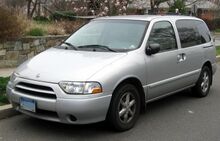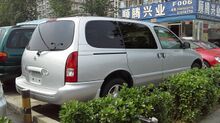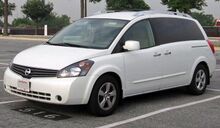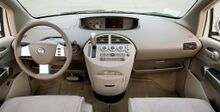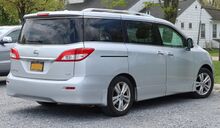Engineering:Nissan Quest
| Nissan Quest | |
|---|---|
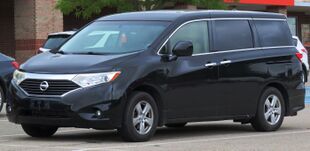 2015 Nissan Quest SV (RE52) | |
| Overview | |
| Manufacturer | Ford Motor Company (1993–2002) Nissan (2004–2009 and 2011–2017) |
| Production | 1992–2016 |
| Model years | 1993–2002 2004–2009 2011–2017 |
| Body and chassis | |
| Class | Minivan |
| Layout | Front-engine, front-wheel-drive |
| Chronology | |
| Predecessor | Nissan Vanette (North America) Nissan Largo Nissan Serena |
| Successor | Nissan Elgrand |
The Nissan Quest is a minivan manufactured and marketed by Nissan for model years 1993–2017 over four generations.
The first two generations (internally designated V40 and V41) of the Quest were short-wheelbase models co-developed and manufactured with Ford, aside its badge engineered Mercury Villager. For model year 2004 and the third generation (V42), Nissan ended its joint venture with Ford, manufacturing the Quest on its own. For model year 2011, the fourth generation (RE52) became a widened variant of the Nissan Elgrand minivan and was now manufactured in Japan. For the preceding generations, the Quest loosely shared its chassis and powertrain with the Nissan Maxima.
Following the decline of minivan sales in North America, Nissan ended sales of the Quest after the 2017 model year.
First generation (V40; 1993)
| First generation (V40) | |
|---|---|
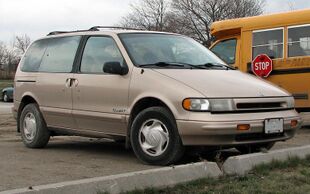 1993 Nissan Quest GXE | |
| Overview | |
| Also called | Mercury Villager Golden GDK6480 (China) Guangdong Nissan Quest (China) |
| Production | April 14, 1992 – July 1998 |
| Model years | 1993–1998 |
| Assembly | United States: Avon Lake, Ohio (Ford's Ohio Assembly) China: Guangdong (CKD) |
| Designer | Thomas Semple (1989) |
| Body and chassis | |
| Body style | 3-door minivan |
| Platform | Ford VX54 platform |
| Related | Nissan Maxima (J30) |
| Powertrain | |
| Engine | 3.0 L VG30E V6 |
| Transmission | 4-speed automatic |
| Dimensions | |
| Wheelbase | 112.2 in (2,850 mm) |
| Length | 189.9 in (4,823 mm) |
| Width | 73.7 in (1,872 mm) |
| Height | 67.5 in (1,714 mm) (Cargo) 65.6 in (1,666 mm) (1993-95 XE) 68 in (1,727 mm) (GXE & 1996-98 XE) |
In 1987, Ford and Nissan entered a joint agreement to develop an all-new vehicle to compete in the minivan segment scheduled for 1991.[1] Development officially began later that year under the codename VX54, with the final designs being chosen in 1989. Prototypes went into initial testing in 1990 at Ford and Nissan test tracks, later real-world testing throughout 1991, with development concluding at the end of that year. On January 6, 1992, the 1993 Nissan Quest was unveiled at the North American International Auto Show in Detroit. Unusually, its design patents were subsequently filed by design chief Thomas H. Semple for Nissan Motor on March 5, 1992, rather than in advance of its introduction.
The first Nissan Quest rolled off the production line on April 14, 1992 at the Avon, Ohio plant sourced from Japanese production. While assembly took place at Ohio Assembly, initial production began in Japan and later at NMMC that August. NMMC production began in June 1992 on the main body components, with engine assembly beginning in August. The Quest was launched in September 1992 and sold 1,358 units during its first month.[2][3][4][5][6][7] The Quest was a successor to the Nissan Axxess, which was sold in the United States only in 1990 (ended production in 1989) and in Canada from 1990 to 1995. It also replaced the rear-wheel drive Vanette, also discontinued in 1990. The Quest was initially powered by Nissan's 3.0 L VG30E SOHC engine that made 151 hp (113 kW) and 182 lb⋅ft (247 N⋅m). For a short time, the Quest was sold in Japan in a right hand drive configuration at Nissan Bluebird Store locations, but due to the engine displacement and exterior dimensions exceeding Japanese Government dimension regulations sales were limited and cancelled after the facelifted version was released in 1996.
Ford required that Nissan make some design changes to the VG30E before they would agree to use it in the Villager and Quest. Changes included the addition of an oil level sensor and relocating the oil filter assembly for better access. The engine was also modified for the Quest and Villager to become a non-interference design: if the timing belt were to break, the pistons wouldn't come in contact with any open valves in the cylinders. The Quest was available as XE or GXE models. Because of manufacturing issues, Nissan had an arrangement for Ford to assemble the minivan in North America, and in turn they were allowed to rebadge it and sell it under the Mercury brand as the Villager. Many of the interior parts, including the radio, heater controls and power windows controls were adapted from Ford, and were similar to the Ford Aerostar. This generation of the Quest and Villager was built at Ford's Ohio Assembly plant in Avon Lake, Ohio. The van shared the modified version of the VG30E from the U11, and early J30 Maximas, as well as the 4-speed automatic transmission from the Maxima.

Seating was for 7, with a removable 2-seater bench in the middle, allowing the third row bench of 3 seats to slide up (either folded up for more room or down for passengers) behind the front for more rear cargo room. The third row seat was not removable however, and the system was not improved in the 1999 redesign (on which the model was not available in Canada), so newer fold-into-the-floor seats and lightweight buckets quickly eclipsed the system. In 1993, a driver's side airbag was made standard. A passenger airbag was later added in 1995 for the 1996 model year. That year saw the introduction of changes to the front and rear fascias, as well as headlights and tail lamps and the elimination of the motorized shoulder belts.
Second generation (V41; 1999)
| Second generation (V41) | |
|---|---|
 1999–2000 Nissan Quest | |
| Overview | |
| Also called | Mercury Villager |
| Production | August 1998 – June 2002 |
| Model years | 1999–2002 |
| Assembly | United States: Smyrna, Tennessee (Nissan Smyrna Assembly Plant)[citation needed] |
| Designer | Shinken Tanaka (Exterior: 1995) Diane Allen (chief designer) |
| Body and chassis | |
| Body style | 5-door minivan |
| Platform | Ford VX54 platform |
| Related | Nissan Maxima (J30) |
| Powertrain | |
| Engine | 3.3 L VG33E V6 |
| Transmission | 4-speed automatic |
| Dimensions | |
| Wheelbase | 112.2 in (2,850 mm) |
| Length | 194.6 in (4,943 mm) (2001-02) 194.8 in (4,948 mm) (1999-2000) |
| Width | 74.9 in (1,902 mm) |
| Height | 64.2 in (1,631 mm) 67.3 in (1,709 mm) |
For 1999, the Quest was redesigned at Nissan Design America in San Diego, California, under Diane Allen, during 1993 and 1995. The production design by Shinken Tanaka was frozen in 1995 and design patents were filed at the Japan Patent Office on November 2, 1995 under patent #1009611.[8][9] The exterior was given a more aerodynamic look, and the driver's side sliding door was added (it had been absent in the three-door Quests from 1993 to 1998). The Quest also got a power boost via the 3.3 L VG33E SOHC engine, making 171 hp (128 kW) and 200 lb⋅ft (270 N⋅m) of torque. With the new 3.3-liter engine, the 1999 Nissan Quest had a 0–60 mph acceleration time of 11.1 seconds.[10] The XE trim was discontinued and the GXE was moved as the base model. Two new trim levels were also introduced: the top-of-the-line GLE and the sport model SE. This Nissan Quest model became the first Nissan minivan with four doors since the 1995 Nissan Axxess.
The 2000 Nissan Quest was tested in a competition organized by Car and Driver against the Chevrolet Venture, Toyota Sienna, Mazda MPV, and Chrysler Voyager. The Quest performed poorly and placed fifth out of the five minivans tested; the editors cited a lengthy braking distance of 220 feet from 70 mph and inflexible seating configurations (the third-row seat was not removable) as downsides, while the Quest's performance and nimble handling were cited as advantages over its competitors.[11]
In August 2000, the 2001 Quest received various minor improvements. Styling front and rear was updated, along with new alloy wheels on all models. The entry-level GXE gained a rear stabilizer bar, while the SE received acceleration-sensitive strut valving and a strut tower brace. New interior gauges and fabrics as well as a 130-watt sound system were standard on SE and GLE. Luxury GLE models also received an in-dash six-CD changer and a wood and leather-trimmed steering wheel. An optional overhead family entertainment system replaced the former floor-mounted model, though it could still be specified for SEs and GLEs equipped with a sunroof. Front seatbelts were given pretensioners. The 2001 Quest was also slightly longer, with more cargo space than the initial models. The 2002 Nissan Quest was not sold in Canada . The Quest would not return to Canada until the third-generation model arrived in 2003.
By the end of this generation, both Honda and Toyota marketed solely long-wheelbase minivans. In 2001, Automotive News reported that 29,232 Nissan Quests were sold, representing a 32% decrease from the previous year.[12] No Quest models were marketed for the 2003 model year.
Third generation (V42; 2004)
| Third generation (V42) | |
|---|---|
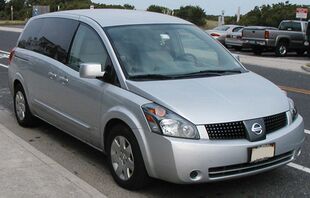 2004–2006 Nissan Quest | |
| Overview | |
| Production | May 27, 2003 – 2009 |
| Model years | 2004–2009 |
| Assembly | United States: Canton, Mississippi |
| Designer | Alfonso Albaisa (2000)[13] |
| Body and chassis | |
| Body style | 5-door minivan |
| Platform | Nissan FF-L platform |
| Related | Nissan Altima Nissan Maxima Nissan Murano Nissan Teana |
| Powertrain | |
| Engine | 3.5 L VQ35DE V6 |
| Transmission | 4-speed automatic 5-speed automatic |
| Dimensions | |
| Wheelbase | 124.0 in (3,150 mm) |
| Length | 204.1 in (5,184 mm) |
| Width | 77.6 in (1,971 mm) |
| Height | 70.0 in (1,778 mm) (2004-06) 71.9 in (1,826 mm) (2007-2009) |
Development began in 1999 on the V42 alongside a proposed Ford replacement. In 2000, decisions were made by Ford and Nissan to abandon the joint venture three years earlier than had originally been planned.[14] Both the Windstar and Quest replacements were then in initial development and undergoing the design process. As a result, Ford made plans to build a Mercury variant on the Windstar (WIN-96) successor's platform due in 2003 and Nissan on the Altima and Maxima platform. The design by Alfonso Albaisa was chosen in late 2000, with a concept vehicle being presented in January 2002 at NAIAS as a thinly veiled preview. Design patents were filed on December 27, 2002 and registered under D483,297 on December 9, 2003. The production third generation Quest was unveiled for the 2004 model year at the 2003 North American International Auto Show using the Nissan Altima and Nissan Maxima platform, Nissan's FF-L platform, in a package slightly longer than the Chrysler long-wheelbase minivans. Production was moved to a new plant in Canton, Mississippi and started on May 27, 2003.[15]
The Quest is powered by the 3.5 L VQ35DE engine from the Maxima, Altima, and others. The 2004 Quest recorded a 0-60 mph acceleration time of 8.8 seconds.[10] In the Quest, it produces 240 hp (179 kW) and 242 lb⋅ft (328 N⋅m) of torque. The Quest has a flat folding rear bench and the two middle chairs fold nearly flat into the floor. The interior volume is 211.9 cubic feet (6.00 m3). Its appearance shows many similarities to the Renault Espace which appeared in 2002.
The third generation Quest features an unusual moonroof glass arrangement with separate panels above each passenger with individual retractable sunshades, while the roof above the passengers accommodates 2 DVD screens with auxiliary input plug, when the VHS shaped IWCC Xl system was discontinued. Also featured in the SE model were side front airbags, curtain airbags for all rows, VSC (Vehicle Stability Control), Traction Control, dual rear power sliding doors and power rear hatch, Bose audio with RDS and folding second row seats, dual climate control, and rear backup sensors. Nissan redesigned the front grille and the dashboard for the 2007 model. They also moved the DVD player from under the front passenger seat to the instrument panel stack.
Production of this generation Quest ended after the 2009 model year, with Nissan stating that the automaker needed room at the Canton plant for production of a commercial vehicle based on the Nissan NV2000 concept.[16]
National Sales figures
2003 - 23,170 (From remaining 2002 & 2004 model early sales)
2004 - 46,430
2005 - 40,357
2006 - 31,905
2007 - 28,590
2008 - 18,743
2009 - 8,564
Quest Concept
In March 2022, a Facebook user found the V42 concept in Nashville, Tennessee waiting to be scrapped. The front end of the concept was nearly identical to the production V42, but the rear end used a different design from the production car.
Fourth generation (RE52; 2011)
| Fourth generation (RE52) | |
|---|---|
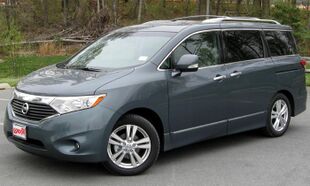 2011 Nissan Quest SL | |
| Overview | |
| Also called | Nissan Elgrand |
| Production | December 2010 – 2017 |
| Model years | 2011–2016 (2017 for the fleet market) |
| Assembly | Japan: Kanda, Fukuoka (Nissan Shatai) |
| Body and chassis | |
| Body style | 5-door minivan |
| Platform | Nissan D platform |
| Related | Nissan Altima Nissan Elgrand Nissan Maxima Nissan Murano Nissan Teana |
| Powertrain | |
| Engine | VQ35DE 3.5L V6 |
| Transmission | CVT |
| Dimensions | |
| Wheelbase | 118.1 in (3,000 mm) |
| Length | 200.8 in (5,100 mm) |
| Width | 77.6 in (1,971 mm) |
| Height | 71.5 in (1,816 mm) |
In 2010, Nissan provided five teaser images of the 2011 Quest revealing the exterior and interior.[17] It was then unveiled at the Los Angeles Auto Show that year.[18] The design was based on the Nissan Forum concept. The Quest also shared its styling and chassis with the JDM Nissan Elgrand, but is 4.7 in (120 mm) wider.[19] It is powered by Nissan's 3.5L VQ series engine with 260 hp (194 kW). The Quest went on sale in North America in early 2011 as a 2011 model.[16][20]
In Japan, the Elgrand competes with the Toyota Alphard and the Honda Elysion, whereas in the American and Canadian markets, the Quest competed with the Chrysler minivans, the Kia Sedona, Toyota Sienna, and the North American Honda Odyssey. The fourth-generation Quest had been built at the Shatai plant in Japan from 2010 until 2016.
The Nissan Quest was dropped from regular production in Canada after 2014 and in the United States after the 2016 model year due to declining sales. A shortened 2017 model year was produced only as a fleet vehicle.[21]
Marketing
To promote its release in China , the Quest was used as a free airport escort service vehicle at Beijing Nanyuan Airport and Beijing Capital International Airport for visitors traveling from those airports.[22]
Safety
Speaking to the results of the 2014 Nissan Quest's small overlap front crash test,[23] Insurance Institute for Highway Safety executive vice president Dave Zuby described it as "one of the worst crash tests we've ever seen." He speculated that "a person experiencing this would be lucky to ever walk normally again."[24][25]
| test | rating |
|---|---|
| Driver's side small overlap front | Poor |
| Moderate overlap front | Good |
| Side | Good |
| Roof strength | Acceptable |
| Head restraints and seats | Good |
Sales
| Calendar year | United States |
|---|---|
| 2010 | 177[26] |
| 2011 | 12,199[26] |
| 2012 | 18,275[27] |
| 2013 | 12,874[27] |
| 2014 | 9,833[28] |
| 2015 | 11,018[28] |
| 2016 | 11,115[29] |
| 2017 | 4,950[29] |
References
- ↑ Mateja, Jim (1987-05-04). "Ford, Nissan Studying Joint Venture On Vehicle". Chicago Tribune. http://articles.chicagotribune.com/1987-05-04/business/8702020971_1_ford-and-nissan-mini-van-smyrna-plant.
- ↑ "Ford To Replace Aerostar For 1994". Orlando Sentinel. http://articles.orlandosentinel.com/1989-12-07/topic/8912062887_1_aerostar-minivan-mercury.
- ↑ "Battle For Mini-van Supremacy Heats Up". Chicago Tribune. http://articles.chicagotribune.com/1991-02-10/business/9101120827_1_general-motors-corp-new-front-drive-mercury-villager.
- ↑ "Patent USD347198 - Automobile". http://www.google.com/patents/USD347198.
- ↑ "NISSAN QUEST PRODUCTION BEGINS". http://www.thefreelibrary.com/NISSAN+QUEST+PRODUCTION+BEGINS-a012048048.
- ↑ "Nissan: Manufacturing, Smyrna, Tenn.". http://www.autointell.com/asian_companies/nissan/nissan-facilities/nissan-us-facilities.htm.
- ↑ "Nissan's Altima and Quest launch full speed ahead with strong September sales". http://www.thefreelibrary.com/NISSAN%27S+ALTIMA+AND+QUEST+LAUNCH+FULL+SPEED+AHEAD+WITH+STRONG...-a012619058.
- ↑ "Design #1009611". Japan Platform for Patent Information. 2 November 1995. https://www4.j-platpat.inpit.go.jp/cgi-bin/tran_web_cgi_ejje?u=http://www4.j-platpat.inpit.go.jp/eng/translation/201509290435494071716847566832425241591B52A3460BA8DEC8C3ABA45B0468.
- ↑ Krebs, Michelle (9 August 1998). "1999 Nissan Quest; Growth Spurt for a Mini Mini-Van". The New York Times. https://www.nytimes.com/1998/08/09/automobiles/behind-the-wheel-1999-nissan-quest-growth-spurt-for-a-mini-mini-van.html.
- ↑ 10.0 10.1 Zero to 60 Times. "Nissan 0-60 Times". http://www.zeroto60times.com/Nissan-0-60-mph-Times.html.
- ↑ [1] Car and Driver: Chevrolet Venture vs. Nissan Quest, Mazda MPV, Toyota Sienna, Chrysler Voyager (Page 3) - by Patrick Beard - November 2000
- ↑ [2] Cars.com: 2002 Nissan Quest Review - by Jim Flammang
- ↑ "Patent USD483297 - Automobile". http://www.google.com/patents/USD483297?dq=toy+replica+automobile+automobile+and+toy&hl=en&sa=X&ei=eHmJUeX1N8bZ0QHqnID4BQ&ved=0CCgQ6AEwBDgK.
- ↑ Lassa, Todd, ed (2000-04-24). "News: The Quest continues". AutoWeek (Crain Communications Inc.) 5 (26): 4.
- ↑ Vasilash, Gary S.. "Infiniti Goes Big". Automotive Design & Production. Gardner Business Media, Inc.. http://www.autofieldguide.com/articles/infiniti-goes-big.
- ↑ 16.0 16.1 "Nissan Says No Quest for 2010 – Automotive News & Car Rumors at Automobile Magazine". Rumors.automobilemag.com. http://rumors.automobilemag.com/6592915/news/nissan-says-no-quest-for-2010/index.html.
- ↑ "LA Live: 2011 Nissan Quest makes world debut, pricing announced". Leftlanenews.com. http://www.leftlanenews.com/nissan-quest.html.
- ↑ Staff, Automobile (2010-11-18). "Los Angeles 2010: 2011 Nissan Quest Minivan Debuts in L.A." (in en-US). https://www.automobilemag.com/news/los-angeles-2010-2011-nissan-quest-minivan-debuts-in-la-5336/.
- ↑ "Next Generation Nissan Quest (R42H) be share New Elgrand (J42H) body Component " Codename, Nissan, QuestElgrand, developingBoth, Shahai, Plant". Autoincar. 2009-07-31. http://www.autoincar.com/next-generation-nissan-quest-r42h-be-share-new-elgrand-j42h-body-component/.
- ↑ "Teased: Nissan Quest". Insideline.com. 2010-03-30. http://www.insideline.com/nissan/quest/teased-nissan-quest.html."The 2011 Nissan Lineup: Charting the Changes". Nissan News. 2010-06-21. http://www.nissannews.com/newsrelease.do?id=1714&mid=1.[yes|permanent dead link|dead link}}]
- ↑ "It's Official: The Nissan Quest is Dead, Discontinued, Defunct, Cancelled". 12 May 2017. http://www.thetruthaboutcars.com/2017/05/official-nissan-quest-dead-discontinued-defunct-cancelled/.
- ↑ "ղƳ¹ʿѽͷ". http://bj.xcar.com.cn/201312/news_1385451_1.html.
- ↑ "Vehicle details". http://www.iihs.org/iihs/ratings/vehicle/v/nissan/quest/2014?print-view.
- ↑ "Minivans Crash Test: Find Out Which Models Failed". The Inquisitr News. http://www.inquisitr.com/1623321/minivans-crash-test-find-out-which-models-failed/.
- ↑ LeBeau, Phil (20 November 2014). "Minivan crash test 'among the worst we've ever seen'". CNBC News. https://www.cnbc.com/2014/11/20/minivan-crash-test-among-the-worst-weve-ever-seen.html.
- ↑ 26.0 26.1 "Nissan North America Sales Increase 7.7% for Record December". 4 January 2012. https://nissannews.com/en-US/nissan/usa/channels/U-S-Sales-Reports/releases/nissan-north-america-sales-increase-7-7-for-record-december?page=5&query&la=1.
- ↑ 27.0 27.1 "Nissan Group Reports December and 2013 Year-End U.S. Sales". 3 January 2014. https://nissannews.com/en-US/nissan/usa/channels/U-S-Sales-Reports/releases/nissan-group-reports-december-and-2013-year-end-u-s-sales?page=3&query.
- ↑ 28.0 28.1 "Nissan Group reports December and 2015 calendar year U.S. Sales". 5 January 2016. https://nissannews.com/en-US/nissan/usa/channels/U-S-Sales-Reports/releases/nissan-group-reports-december-and-2015-calendar-year-u-s-sales?page=2&query.
- ↑ 29.0 29.1 "Nissan Group reports December and 2017 calendar year U.S. Sales". 3 January 2018. https://nissannews.com/en-US/nissan/usa/channels/U-S-Sales-Reports/releases/nissan-group-reports-december-and-2017-calendar-year-u-s-sales.
Bibliography
External links
- Nissan USA Quest site
- Official Quest Information Page
- AutomobileMagazine-2005 Nissan Quest (review)
- QuestDriver Forum Community
 |
